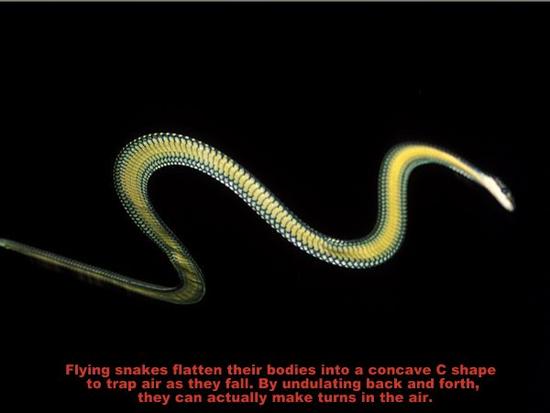
Flying snakes are a small group of species of tree snakes that live in South and Southeast Asia. At rest they appear unremarkable, but on the move they’re able to take to the air by jumping from the tree, flattening the entire body, and gliding or parachuting to the ground or another tree.
Chrysopelea or known more commonly as the flying snakes, is a genus belonging to the family Colubridae. Their range of habitat is mostly concentrated in Southeast Asia, the Melanesian islands, and India. Their ability to glide has been an object of interest for physicists and the United States Department of Defense in recent years, and studies continue to be made on what other, more subtle, factors contribute to their flight. According to recent research conducted by the University of Chicago, scientists discovered a correlation between size and gliding ability, in which smaller flying snakes were able to glide longer distances horizontally.
Once thought to be more parachuters than gliders, recent scientific studies have revealed intricate details about how these limbless, tube-shaped creatures turn plummeting into piloting. To prepare for take-off, a flying snake will slither to the end of a branch, and dangle in a J shape. It propels itself from the branch with the lower half of its body, forms quickly into an S, and flattens to about twice its normal width, giving its normally round body a concave C shape, which can trap air. By undulating back and forth, the snake can actually make turns. Flying snakes are technically better gliders than their more popular mammalian equivalents, the flying squirrels.
Scientists don’t know how often or exactly why flying snakes fly, but it’s likely they use their aerobatics to escape predators, to move from tree to tree without having to descend to the forest floor, and possibly even to hunt prey.
Flying snakes are mildly venomous, though they are considered harmless because their toxicity is not dangerous to humans. Their prey includes lizards, frogs, birds and bats.
Via: nationageography
Flying Snake




